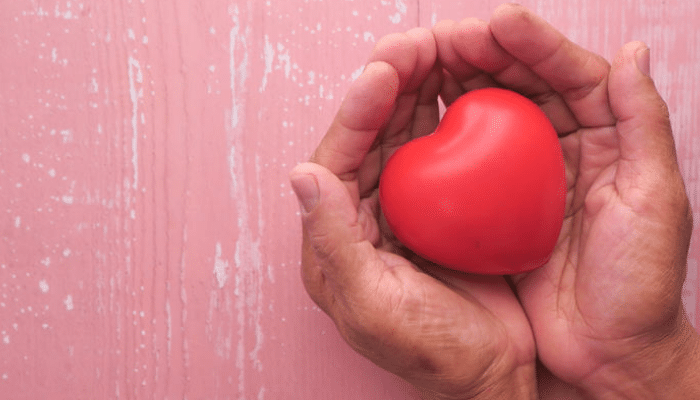Are you feeling overwhelmed by caregiving during these challenging times? If so, you are not alone. Parenting and caregiving are always filled with uncertainty and difficult emotions, but the past year has been especially intense, and many caregivers are suffering from burnout.
Practicing self-compassion increases resilience and provides the emotional resources needed to care for ourselves and for others. In this webinar, Dianna Collier, a certified positive psychology coach, a licensed specialist in school psychology, and the mother of two teen daughters, shares practical strategies and tools for tapping into the powerful resource of self-compassion to help support ourselves and others during these tough times.
As part of our WBI/JCC Online Positive Psychology Hour webinar series, Dianna spoke with Caroline Kohles, Senior Director of Health and Wellness at the Marlene Meyerson JCC Manhattan.
Highlights from the Conversation
So we’re talking about self-compassion today. I’m fascinated by that. How did you come to this topic?
The good thing is that with self-kindness, you activate another biological process, which is the attachment affiliation system. That’s really the biological need to connect and get the support from others. To demonstrate these two different things, I’d like everybody to make a strong fist with your hand and just hold it tight. This represents your inner critic. Feel that tension, and then release it and put your hand over your heart, and take a moment feel how that feels. That is the self-kindness. That’s what we’re trying to do, we’re trying to shift from a state of that tension, the tension that is created by the inner critic, to the softening of the self-kindness.
The next element that I think is extremely important is the common humanity versus isolation. When we are suffering, and we all suffer as humans, it is a tendency to think it is just us. And it’s not. There is no escape to suffering. And it’s just part of life. It’s part of being a human. And while people have different flavors of suffering, it’s very comforting to recognize how common this is. It’s also particularly interesting right now, because many of us are experiencing very universal suffering brought on by the pandemic, and a lot of unrest, certainly in the US, but not just in the US.
The other aspect that’s really important is understanding that imperfection is a part of life. Perfection is a myth, it really doesn’t exist. And that’s okay. That’s fine. That’s good. And then mindfulness, the third aspect, mindfulness versus over identification. First of all, you have to be able to recognize that you are suffering. But this isn’t about getting lost in the suffering. So the mindfulness aspect is noticing it, and not necessarily trying to change those painful feelings, but welcoming them and not getting lost in the storytelling of it, just noticing it. So you’ve got the self-kindness, you’ve got the common humanity, and you’ve got the mindfulness.
In my own personal experience, one of the benefits that I have found in my practice is that I’m able to sit with my own intense emotions more strongly, and the intense emotion of those around me, particularly my children. My household right now is my husband and my two teenage daughters, and up until the beginning of December, it also included our dear, very old dog and she passed away so we had a lot of pain associated with that, and self-compassion was very important for me, to be able to be present with those emotions. Whether it’s someone in your house or a friend that you’re talking to on the phone, having the ability to not problem-solve, and not try and fix things, but to just sit there and be there with someone is huge, and it’s a huge gift to them. And self-compassion can help you with that.
The other day, I was sitting in the car waiting to pick up my children, anticipating a difficult situation, and I just sort of rubbed my hands back and forth on my legs. It was just a private soothing moment. That’s where soothing touch can be really helpful. You could be on a Zoom meeting, or in a car, and you can rub your hands and people won’t know. You can be in front of the people who are triggering you and they don’t know what you’re doing.
And then find the soothing touch. Maybe the one that felt best to you today. Add that soothing touch right now. Because you’re acknowledging that you are in pain, that this situation is a very hard and painful situation. But you’re not alone. May I be kind to myself in this moment, that’s what you want to find—words that are meaningful to you. Some other examples might be, May I give myself the compassion that I need. May I accept myself as I am. May I forgive myself. You may want to think about language a good friend uses with you if you are particularly struggling. So it could be, I’m here for you. I care about you. Oh, honey, I’m so sorry. Or Oh, sweetie, or your name, even that might feel good. The words you use are completely up to you and will probably vary. So you just want to notice that and say, Wow, this is hard. I’m not alone. And I deserve some compassion and love. Oh honey, I’m here for you. Lately, I’ve been using this every day.
Dianna: Yes, absolutely. And that is our go-to, the criticism. So that’s why it takes a little extra work to to do the compassion because [the self-criticism] is part of our survival instinct. One of the ways that you can work with your inner critic, which is there, too, is to recognize that although the words are not very nice that you often say to yourself—and personally, I’ve never had anybody say anything as ugly to me as what I’ve said to myself—your inner critic is actually trying to take care of you. So sometimes it’s like, Okay, I hear you, I hear you’re worried about me, you’re wanting me to be taken care of, and I know you want to take care of me, and this is a better way I can be kind to myself. So that’s a technique, too, for working with some of that. And you’re never going to be always self-compassionate. I think it’s important to recognize that this really is a practice. You’ll catch yourself, the more you do it, and then hopefully respond with that kindness.
Caroline: Research shows that when we are more compassionate, we actually are more productive, we are more successful, we are more willing to try new things and take bigger risks. So it’s this counterintuitive thing where we want to be hard on ourselves in a way or we’re used to that, but it’s almost an upgrade to say when I’m going to recognize how I’m feeling and the message that I’m getting from my brain,I’m going to shift it to a compassionate outlook, and then I can make different choices.
Dianna: Absolutely. And I think this is a wonderful skill to model for the children around you, too. It’s not something that really has been taught. And there is that huge fear of failure, but we can create that hope and the momentum and encourage each other.
So the next practice is a practice that Kristin Neff developed called “compassion with equanimity.” And that practice was specifically developed for caregivers to deal with burnout. You can find recordings of her leading this and Chris Germer, too. It is a little bit of a longer meditation—and it doesn’t have to be a meditation. The way that the tools are taught here are in that meditation perspective, but there’s always a way to adapt it in the moment. This is a practice that I’ve used versions of say, as I mentioned, when our dog passed away and near the end, she was very sick and there were many many mornings where I was spoon-feeding her or doing some hands-on nursing. Even though it was developed for caregivers, it’s just a really wonderful practice for when you’re having any relationship difficulty, which includes everybody. Perhaps in your family there’s a difference in political views—this is a practice that will teach how to include compassion for yourself with compassion for others. This is a solid eight-minute practice and this is probably the most intense of the practices that I will teach.
So to, to start, just get yourself comfortable. And let’s take just a few deep breaths to settle in to the present moment. So breathing in and out. I love to breathe out through pursed lips, it’s very calming.
Pull up a situation—somebody that you are caring for, or who is exhausting you, frustrating you. Maybe somebody you care about who is suffering. This could be a caretaking situation. But it could just be somebody that you interact with. And if you have several candidates right now, lots of people coming up, that’s okay. You want to pick just one for the exercise, and you can return and do this again, with someone else, or a different situation. I recommend that you might not choose the most complicated and tense relationship if this is new to you in particular. The exercise is beautiful for those relationships, too, but for practicing, you want to pick a painful kind of hard situation, but maybe not your maximum right now.
So bring to mind this person and visualize the person in this caregiving situation, or this really hard, hard situation. Visualize it in your mind. Feel that struggle in your body. Notice the pain that you’re feeling. Think about the details. Now, as you think about this person I’m going to read some words and and just let them gently roll through your mind. We are each on our own life journey. I am not the cause of this person’s suffering. Nor is it entirely within my power to make it go away, even though I wish I could. Moments like this are difficult to bear. Yet, I may still try to help if I can.
Now be aware f the stress you’re carrying in your body; inhale fully and deeply, drawing compassion inside your body and filling every cell of your body. You might visualize this compassion as a warm golden light, breathing that in to your body.
You may want to add some soothing touch if you haven’t already. Let yourself be soothed by inhaling deeply and by giving yourself the compassion that you need. Now as you exhale, send out compassion to the person who is associated with your discomfort.
Continue breathing compassion in for yourself and out for the other person, allowing your body to find a natural rhythm with your breathing, you don’t need to do anything differently with a breath. Let your body just breathe itself, breathing in compassion for yourself. Breathing out compassion for the other. One for me, one for you. In for me, out for you. Occasionally, scan your inner landscape for any distress you may be feeling and respond by inhaling that compassion for yourself into that part of your body. And then exhale that compassion for the other. And you might find that you need some extra compassion here. It’s very possible that your pain in dealing with this very difficult situation is is really strong and it is calling to you. And so in that case, you want to bring some extra breaths for yourself, bring in more compassion for yourself. So focus your attention in your breath, breathing in the compassion for yourself. And that might be that you also feel like it could be right to send out a little bit more compassion to the person who is suffering, the person that you are caring for. You can send out extra exhales of compassion for that person, but always grounded in your own personal compassion for yourself. So first compassion for yourself, and then the other.
Let yourself float on an ocean of compassion. There is no limit to the compassion. There’s enough for everybody, for yourself and the other. In and out.
An all this compassion, this ocean of compassion embraces all suffering. Take in these words once again. We are each on our own life journey. I am not the cause of this person suffering nor is it entirely within my power to make it go away, even though I wish I could. Moments like this are difficult to bear. Yet I may still try to help if I can.
Now we’re going to start to let go of this practice and allow yourself to be exactly as you are in this moment. You do not need to change, correct, or solve the situation, and all your feelings are okay. That’s part of being human. You can let go, let go for the moment of the situation. And when you’re ready, you can gently open your eyes.
This practice for me ,when I first heard it, brought me to tears. Although it is true that sometimes I’ve heard Kristin Neff and Chris Germer say sometimes you shouldn’t focus on your child, because it’s complicated, I think a lot of relationships, whether you’re caring for parents, your spouse, a client, they can all be pretty complicated. And tears are normal whenever you are releasing some of that. But this practice of breathing in and out compassion for yourself and for others is something you can really practice in the moment in a situation. Whether in the exact moment you’re caring for somebody, you know that breathing in and out compassion will regulate your nervous system. And definitely, if you’re in close contact, that regulation of your nervous system passes on to those around you. Kristin Neff gives an example of when her son, who has autism, was a baby, he was crying and crying on a plane, and there was really nothing that she could do after she tried everything. And then in the end, she just was breathing in and out that compassion, giving herself that compassion. And that got her through the moment. I don’t remember exactly if her son calmed in that moment. But I think in general, we often see that there’s a calming for others, too.
This is a quote from Kristin Neff that really speaks to me: “We don’t give ourselves compassion in order to feel better. Instead we give it because we feel bad. The burden doesn’t always get lighter but the back gets stronger.”

Dianna Collier
Dianna Collier, M.A. is a Certified Positive Psychology Coach, Licensed Specialist in School Psychology and Personal Renewal Group Facilitator. She leads groups and meets with clients in Austin, TX and online. Dianna has a passion for helping women develop self-compassion, tap into their strengths and discover the power of self-care. She is the mother of 15 and 16 year old daughters. For more information & to contact Dianna, check out her website: www.diannacollier.com
Learn more about the Positive Psychology Coaching Certification and Certificate in Wholebeing Positive Psychology


